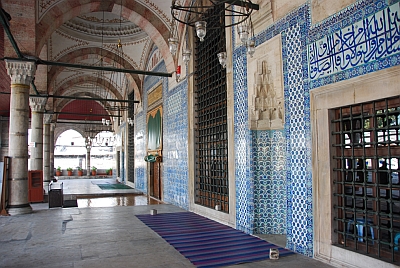Every day, tourists speaking scores of different tongues descend upon Istanbul’s justly renowned monuments and markets. The bustling metropolis is now a regular port-of-call for Mediterranean and Black Sea cruise ships disgorging their passengers for day-trips that invariably include the Blue Mosque, Topkapi Palace, and Covered Bazaar. Though more independent, the oil oligarchs in chauffeured Mercedes and booted-backpackers tend to visit exactly the same places as the mass-market guests…

And virtually ALL of them miss the tiny Mosque of Rustem Pasha, a superb example of Ottoman Turkish architecture and applied floral ornament. The explanation for this omission lies in the urban streetscape: despite its location only a few meters from the fabled Spice Bazaar (a pungent stop on most tours), very few tourists stray from the standard routes to find this mosque, tucked into a busy commercial district where narrow alleys thwart the intrusion of tour buses.
Secrets persist in this city whose ancient name, Byzantium, is synonymous with convolution and intrigue, and the Mosque of Rustem Pasha is one of mine. I debated whether or not to extoll its attractions in this public forum. But as I believe that one must first know something exists in order to appreciate and protect it, I’ll hope that you will see here this article as it leads readers to negotiate the maze of lanes in Old Stamboul. To find Rustem Pasha, one must ask along the Cicek Pazari, Balkapani, Hasircilar, and Tomruk streets—each named for commodities sold there—plants & flowers, honey, rush mats, lumber… Only then will one find this urban oasis of calm and beauty.
As both the son-in-law and Grand Vizier of Suleyman I (a.k.a. “the Magnificent”), Rustem Pasha had wealth and access to the finest artists of the 16th century. To build his mosque, completed in 1562, he hired the sultan’s own master architect, Sinan, whose creativity is evident in this unusual building, erected a full storey above shops that obscure its very existence. Street-level shops are both a physical and financial foundation, the commercial rents contributing to the ongoing maintenance of the building. While this revenue system is common throughout the Muslim world, in this case, the low visibility of the mosque is remarkable. Even the short staircases leading up to the mosque are concealed. Ascending to the open courtyard of the mosque, one steps into a different world. Surrounding a courtyard with a central fountain are domed arcades casting welcome shadows above a deep, raised porch. In the cool shade, a seller of tespih, prayer beads, usually sits reading the Koran…

Drawn in by colors glinting beneath the arcades, one approaches the porch to discover brilliant turquoise, vermilion, and cobalt panels of waving blooms and banners of dancing calligraphy. Thousands of tiles, as brilliant today as they were over four centuries ago, represent the best work of Istanbul’s court designers and the ceramicists of Iznik, whose kilns fired tableware and wall tiles for the Ottoman elite. Along the porch, tile renditions of pointed arches serve as niches to direct the faithful towards Mecca on Fridays, when there may be a full house and late-comers must pray in the open courtyard. The arches also frame views of the floriferous hereafter promised to the faithful.
Even prior to entering the building, as eyes adjust from the brightness of the open courtyard to the shade of the porch, one realizes that this mosque is not only a place of prayer serving the local merchants five times each day. It is also metaphor for something else: a garden. Muslim monuments have long been sited amidst irrigated plots and orchards that beautify a building and expand its contemplative space. In addition, produce from such land has been sold to help support many a building complex with its attendant charitable activities. But in the middle of the 16th century, this Istanbul market was as congested as it is today; there was no open land to spare.

So Sinan created space, almost literally out of thin air, by building above the street and taking what we might think of as “Ottoman air rights.” As is often the case, the first step to creating a garden is to set space apart. (The very word paradise is from the Persian, meaning “a wall around.”)
Next, the architect brought the idea of the garden inside his creation through applied decoration. The flowers ornamenting this mosque would know no season, require no cultivation, and most importantly, would never fade. (Considering the ego and powerful political influence of his client, Sinan would have sought to flatter Rustem Pasha by assuring him of the “sustainability” of the decoration and the benevolent message it would carry to future generations visiting his mosque.

But to continue with one’s visit in our own time…
As an elderly attendant holds aside a heavy curtain across the central portal, one slips off shoes and steps into a soaring, but small, vaulted space. Multiple windows piercing tympani and domes allow light to flood the space. Sunbeams bounce from the glassy tiles covering virtually every eye-level surface.
Inside and out, the mosque is strewn with flowers. Late Greek, Roman, and even Chinese references can be seen in the curling leaves and cloud-bands that characterize the “Saz Style.” Thickets of naturalistic flowering branches complement arrangements of clearly recognizable flora in the Imperial “Four Flowers Style,” which celebrates the rose, tulip, carnation, and hyacinth.
The sultan’s ateliers at Topkapi employed skilled designers, miniature painters, and calligraphers whose influence was felt at every social level and in every medium from book illustration, metalworking, cabinetry, textiles, and ceramics to architecture. The marriage of exquisite Iznik tiles and architecture designed to showcase them is nowhere more harmonious than in the Mosque of Rustem Pasha.
—Holly Chase